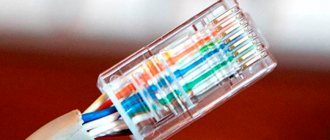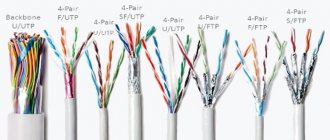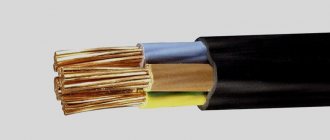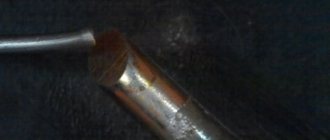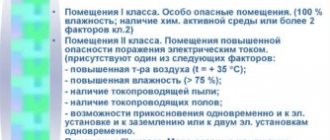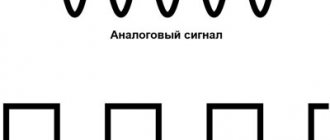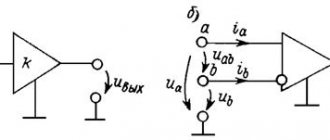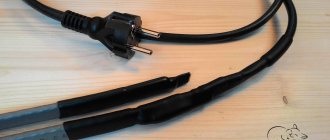Definition and device
So what is twisted pair and why is it actually twisted? The fact is that this cable consists of pairs of conductors twisted together. The choice of conductor material, number of turns, insulation and the presence of a screen determine the throughput, range and operating conditions of the cord. Internet cable is used to connect devices and transmit information using Ethernet technology.
The main difference from other cables is that one conductor wraps around the other, which is why the cable has this name. The signal is applied to both conductors of the pair at once, but along one of them it travels in antiphase. When receiving a signal through a pair of wires, the useful signal is summed (because it goes in antiphase), and the interference is subtracted (they go in the same phase). This way you can get rid of a lot of signal interference. Additionally, the cores are twisted together to reduce interference.
Screen types
While shielding can reflect electromagnetic interference, the main difference between shielded twisted pair cables is the type of shield used. A shield is an electrically conductive material that is wrapped around a wire. For this, two main types of screens are used: foil and braid, which can be used either individually or in combined versions.
When thin aluminum foil is used for shielding, it provides complete surface coverage. But since the foil is thin, grounding work is difficult. Braid is another type of shield used for shielded twisted pair cables. It is a woven mesh made of copper or similar metal wire. Its main advantage is that it provides low resistance and is also easier to deal with grounding. The disadvantage of braid is that it does not completely cover the surface. Shielding in such a wire can reduce electromagnetic interference in two ways:
- 1.The shielding may reflect electromagnetic interference;
- 2.We can ground the shield so that it can pick up electromagnetic interference from the environment and transmit it to the ground through the drain wire.
These cables are typically used for network installations where heavy electrical equipment is used and there are a large number of electrical devices that may cause electromagnetic interference.
Application benefits
Advantages of using it over other types of cables:
- Availability;
- Easy installation due to the small thickness and flexibility of the cable;
- Convenience of working with the cable, since it does not require expensive equipment;
- Strength and durability.
Kinds
There are many types of twisted pair cables. It may differ in the number of cores, the presence or absence of shielding and the type of shell. Each of these types is suitable for a specific technology and operating conditions.
Number of cores
The wire consists of cores. The number of these cores must be a multiple of 2. At the moment, there are cables with one pair - 2 cores, with two pairs - 4 cores and four pairs - 8 cores.
Shielding
The cable can be shielded or unshielded. It is quite suitable for home use without shielding. The screen type is selected based on external conditions and possible interference with the wire.
- U/UTP – without a screen, used in homes and offices where there is no strong interference;
- FTP (F/UTP) – with a screen made of foil;
- STP (S/UTP) – shielding occurs due to copper braiding over all pairs;
- S/FTP, SF/UTP – foil on each pair and all pairs on top are shielded with copper braiding;
- U/FTP – each pair is shielded with foil;
- F/FTP – foil on each pair and a common foil layer;
- SF/FTP - this type of cable has three shields. Each pair is shielded with foil; additionally, all pairs together are shielded with foil and shielded on top with copper braiding.
The foil layer protects from the environment and oxides. Copper braiding is designed to protect the cable from electromagnetic interference.
Shell
Depending on where the cable is used, several types of sheath are used.
- PVC – plastic shell, used for indoor installation;
- PE – polyethylene layer. More durable than plastic shell, can be used outdoors;
- PP – polypropylene layer, resistant to the external environment and temperatures up to 140 degrees Celsius;
- FR – protection, capable of being in an open fire for up to 180 minutes;
- LS – when the cable burns, a minimum of smoke is released;
- ZH – non-toxic when burning;
- B – armor, used when laying cables in the ground;
- C – wire with a power element, used when suspending the cable.
Twisted pair cable markings: Cu and CCA, UTP and FTP
Twisted pair is a type of communication cable, which is one or more pairs of insulated conductors, twisted together (with a small number of turns per unit length), covered with a plastic sheath.
Twisted pair cable is used when laying local area networks, and is also used in video surveillance systems built on the basis of IP cameras.
In this article we will talk about the markings of this type of cable, as well as which twisted pair cable to choose for organizing a video surveillance system.
Cu or CCA
There are two conductors that are used in the manufacture of twisted pair cables - copper (Cu) and copper-coated aluminum (CCA). The cost of a cable based on copper-clad aluminum is significantly lower than the cost of a copper cable, however, compared to copper, copper-clad twisted pair has a number of disadvantages:
— lower electrical conductivity, which reduces the maximum length of the route from the camera to the switching device;
— high probability of contact oxidation;
— low compatibility with PoE technology.
Copper cable, despite its higher price, is practically devoid of the described disadvantages. Networks built on twisted pair copper last longer and require less maintenance. Do not forget also about the greater maximum length of the route from the camera to the switching device, which is due to the greater electrical conductivity of the copper cable.
UTP and FTP
UTP cable and FTP cable differ in design:
- UTP cable (Unshielded Twisted Pair) is an unshielded twisted pair, the cores are covered with PVC insulation and have a common sheath of polyvinyl chloride;
- FTP (Foiled Twisted Pair) cable is a shielded twisted pair; FTP cable has the same structure as UTP cable, except for the presence of an overall aluminum foil shield that provides protection from external electromagnetic radiation.
It would seem that using an FTP cable is preferable. But there is one condition under which the screen will work: together with the FTP cable, appropriate equipment (router, switch) with grounding for the screen must be used. Otherwise, using this type of cable is impractical, since its price is much higher than that of a UTP cable, and a screen without grounding may begin to act like an antenna and attract interference.
In our store you can inexpensively buy high-quality copper twisted pair cables. You can choose from either unshielded outdoor or indoor UTP cable or shielded outdoor FTP cable. All cables are available in Krasnoyarsk. If the buyer wishes, we can send it to any city in Russia.
Categories
The most widely used category is 5e. It is this ethernet cable that connects the equipment of the provider and the apartment router. The same cable connects various devices to the router, such as a personal computer, TV, game console, etc. But there are actually many more categories. Some are no longer used due to insufficient bandwidth, while others, on the contrary, are not used in everyday life due to too high bandwidth and, therefore, high cost.
Wire is divided into categories based on the number of cores, the number of turns, and the frequency range used. These parameters will determine the data transmission speed of the twisted pair and the maximum distance it can transmit it without losing the signal.
- Cat.1 – 1 pair operating at a frequency from 0.1 to 0.4 MHz. Used for analog telephone line and Internet access via modem;
- Cat.2 – 2 pairs operating at frequencies from 1 to 4 MHz;
- Cat.3 – 4 pairs operating at 16 MHz. Used for Ethernet standard 10BASE-T (speed 10 Mbit/s) and 100BASE-T4 (100 Mbit/s). The specified speed is guaranteed for a cable length of up to 100 meters;
- Cat.4 – 4 pairs at 20 MHz. Suitable for Token ring and 10BASE-T, 100BASE technology. The speed using such outdated technology cannot be higher than 16 Mbit/s. Now no longer applicable;
- Cat.5 – 4 pairs at 100 MHz. Used in the 100BASE-TX standard, 100 Mbit/s. Maximum length – 100 meters;
- Cat.5e – 4 pairs operating at 100 MHz according to the 1000BASE-T standard, provides speeds up to 1000 Mbps. The maximum length of a category 5e twisted pair cable to maintain the specified speed is no more than 100 meters;
- Cat.6 – 4 pairs. Frequency 250 MHz. Used in Fast Ethernet and Gigabit Ethernet (10GBASE-T) technologies. Capable of providing data transmission up to 10 Gbit/s at a distance of up to 55 meters;
- Cat.6e – 4 pairs at 500 MHz. used in technology (10GBASE-T) and provides speeds of up to 10 Gbit/s at a distance of up to 100 meters;
- Cat.7 – 4 pairs, operating frequency is 600 MHz. Used in technology (10GBASE-T). Speed 10 Gbit/s with cable length up to 100 meters. Refers not to UTP, but to S/FTP. It uses not only a common screen, but also a screen for each pair;
- Cat.7a – 4 pairs, operating frequency 1200 MHz. Used in Gigabit Ethernet (40GbE, 100GbE) 40 Gbit/s up to 100 meters, and 100 Gbit/s up to 15 meters.
Types of UTP cables
TPPEP cable
The Internet, communications and the development of digital data networks are becoming more and more in demand every year. Manufacturers of UTP wires do not lag behind global technical trends, therefore they constantly release new product samples that stand out for their improved properties. Hence the wide variety of these conductor products.
In practice, the following types of UTP cables are especially common:
- Cat. 1. Used at frequencies from 100 to 400 kHz, therefore suitable for working with older models of modems, in telephone lines and for transmitting analog voice signals. The cable contains only one twisted pair. This type of conductor is obsolete and is gradually being phased out. Therefore, we can assume that such a UTP product is no longer used for modern installation.
- Cat. 2. Operating frequencies – from 1 to 4 MHz. Suitable for use in outdated computer networks and other slow communication channels. In this case, two twisted pairs are used in one cable.
- Cat. 3. Maximum frequency – 16 MHz. Suitable for use in Ethernet networks, which are common in industry. The cable structure involves the use of four pairs of conductors.
- Cat. 4. Up to 20 MHz. This type of cable is more modern. There are also 4 pairs of copper wires hidden under the outer insulation. The throughput of such a product is up to 16 Mbit/s for each pair. The category is known for its use in data lines operating under the outdated token ring protocol.
- Cat. 5. Frequency range – up to 100 MHz. Used in Fast Ethernet computer networks. The cable throughput is up to 1000 Mbit/s when using all 4 twisted pairs simultaneously. This type is suitable for laying local networks.
- Cat. 6. A more serious frequency threshold - up to 250 MHz. 4 pairs. The main purpose is 10 Gigabit Ethernet networks. Accordingly, the data transfer rate threshold reaches 10 Gbit/s. (on a line up to 55 meters long).
- Cat. 7. This type of cable is similar to the previous one, also 10 Gbit/sec. The main difference is the use of both an individual screen on each core, and a general one protecting the entire line. This structure classifies type 7 rather as FTP wires.
Types of conductors
Wire is made from different materials with different thicknesses. And the price greatly depends on their quality and cross-section.
Material
Copper is considered the canonical metal for wire. But it is quite expensive in itself, and is not always needed for use. Therefore, at the moment you can see three main materials:
- Aluminum. A wire made of aluminum is much lighter and cheaper than copper. These are all its advantages, then there are only disadvantages. The electrical conductivity of aluminum is 1.7 times lower than that of copper. In small areas this is not noticeable, but in long areas bordering on the maximum permissible lengths it can become a serious problem. Connectors may slip off aluminum wires over time. The material is highly susceptible to corrosion and its use is unacceptable in damp rooms or outdoors, since due to corrosion damage the electrical conductivity of the core is significantly deteriorated. Aluminum wire is not as flexible as copper wire, so it is somewhat more difficult to install and easier to damage. The ideal place to use a cable with aluminum conductors is a dry room, for example, an apartment or office, where the cable length does not exceed half that allowed by the standard used. This cable will not power devices using PoE (Power over Ethernet) technology. This technology allows signal and power to be transmitted to the device through this wire;
- Copper-plated aluminum. It is an aluminum cable with a copper layer applied to its surface. This cable is also much lighter than copper, but not so cheap. The difference with copper cable is about 15%. The advantage over pure aluminum cable is improved electrical conductivity and corrosion protection. But even though the conductivity is already much better than that of aluminum, PoE technology does not work well on such a cable;
- Copper. Wire made from copper is heavier and more expensive than all others. But it is precisely this that allows you to squeeze out everything that is intended from the technology used. And it is with the copper version that the throughput of the twisted pair will be maximum. A network built from copper cable will be of the highest quality and most durable.
Conductor design
Conductors can be single-core or multi-core.
- Single-core (Solid). It is a solid core of one conductor. Suitable for transmitting signals over long distances. Suitable for crimping with hand tools;
- Stranded, consists of several conductors twisted in a spiral. More flexible and well suited for making patch cords. Not very suitable for crimping with hand tools.
Section
The thicker the cross-section of the twisted pair core, the more information can be passed through it, and the higher the transmission range. The division into categories already implies that the required wire cross-section will be maintained for the selected cable category. To mark the conductor cross-section, a marking was invented - AWG. This abbreviation is translated into Russian as – American wire gauge. To put it simply, each AWG value has its own core diameter and cross-sectional area. For single-core and multi-core cables these values will be different.
For Cat.5e the standard is 24AWG. This means that for it to work properly, the diameter of each wire must be 0.511 mm, which means a cross-sectional area of 0.205 square meters. mm.
Marking
The characteristics that network communication cables must support, and under what conditions, are described in the ISO 11801 (edition 3) standard. But for the average user, and even for a cable network installer, this knowledge is redundant. To build a high-quality local network, the parameters described here are sufficient.
To understand what twisted pair markings are currently in use, you can simply take a piece of cable and look at what is written on it.
From the image you can see that the following information is indicated on the cable:
- U/UTP is information about the screen being used, it is not here;
- Cat 5e – cable category. This twisted pair cable supports a maximum speed of 1Gbps over a distance of up to 100 meters;
- PVC – a plastic sheath is used for indoor installation;
- 4x2x0.48 – the cable consists of four pairs. The core diameter is 0.48 mm. Other markings may be used where the AWG value is indicated instead of the diameter, for example, 4x2x24AWG;
- SOLID – each core consists of one conductor;
- Verified to ISO/IEC 11801 – compliance with the specified standard;
- 07/16 – release date;
- 284m – remaining or used cable footage.
Cable selection
The wire is selected based on the operating conditions and the technology used. It is worth choosing a wire of the Cat.5e category. If the installation will take place indoors, then you can choose a cable for the Internet - twisted pair without a U/UTP screen. If the cable may be exposed to various interferences, then depending on their strength, shielding must be selected. For a dry and warm room where the cable will not be exposed to direct sunlight, you should choose a PVC sheath. For more aggressive environments and for cables that will have an important function, it is worth choosing a stronger outer sheath. For laying in the ground you need to choose a cable in armor B, and for suspension C.
For maximum transmission quality, a single-core cable made of copper should be used. If high speeds and long cable lengths are not provided, then you can save money by choosing an aluminum or copper-plated type of design.
